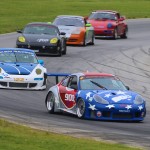Daytona Track Notes
At the 2012 PCA Club Race at Daytona, Cory was asked to conduct the chalk talk. Over 50 drivers attended his presentation, which included in-car video in a few different cars and a hand-out featuring track notes for driving Daytona. We received great positive feedback on Cory’s chalk talk, so we’re posting the track notes for drivers who were not able to attend.
Turn1-2:
You will approach the braking zone into T1 in top gear. This is the highest terminal speed of any road racetrack in North America. The goal is to make the braking zone as straight as possible. If traffic allows, set up from the right side of the track. In most cars braking at the 1 marker is possible. (Since the repave of the oval, the brake markers have been moved further up the road – away from the turn. The “old” 1 marker is later than the new one). The new pavement has a lot of traction. Try to make a straight line from the outside of the oval, in toward the grass on the left side and through toward the outside of the track as you enter T1. Let the car carry about two-thirds of the way out before turning in. Trail brake slightly to help point the nose into the apex. Smoothly release brake pressure and start to pick up the throttle at the apex. Squeeze down to full power and allow the car to track out toward the exit curbing. There is more room at the exit than it seems, which means you can get to full power a little sooner than you might expect. It is normally not required (or preferred) to track out all the way to the exit curbing, so use the entire track only if needed. The following right-hander at the beginning of the Esses is much more gradual if you are not at the far right of the road tracking out of T1. Continue at full power all the way through the Esses, letting the car free up toward the outside exiting the left-hander.
Quick notes:
- Brake as straight as possible for maximum braking performance.
- Most cars can brake at or just beyond the “1” marker.
- Reach full power as soon as possible to achieve the best run down the long straight toward the east horseshoe.
East Horseshoe:
Transition to the left side of the track. If no one is exiting the pit lane, swing out over the pit exit transition line. Brake as deep as possible and trail brake almost to the inside apex curbing. Be sure to drive all the way to the inside curb to maximize the corner radius. Two wheels on the curb is the goal. The entrance to the corner is a long distance so trail braking into the turn is important to a quick lap time. After the brake pressure release, allow the car to coast for a short amount of time before picking up the throttle. This allows the nose of the car to take the final set before exit. (Reduces corner exit under steer). Quickly squeeze down to full power and un-wind the steering. Allow the car to carry all the way to the exit curb. Use up the entire track. On higher power cars, expect a little wheel spin induced over steer at the exit.
Quick notes:
- Use the pit exit lane to maximize the corner radius.
- Trail brake toward the apex curb.
- Two wheels on or slightly over the inside curbing.
- Early to power and use the entire road at the exit, going over the exit curb is ok.
Kink/Dogleg:
Transition back over to the right side of the road after exiting the horseshoe. In some cars the kink is flat out. In higher power cars, it’s a lift and go. The corner is faster than it seems. There is a little camber in the road at the apex, which helps grip. If a lift is required, breathe a little early and power through the apex. This helps settle the rear through the corner. Be very smooth with the inputs. The inside apex curb is fairly abrupt, and hitting it will upset the car, just touch it, DO NOT HIT it. Try to determine early if you can’t make the corner exit. Do not snap off the throttle after the apex. The rear of the car will unload and get very light, which could cause it to snap hook toward the inside and into the wall. Open the steering smoothly and keep the vision high all the way though the corner. Speed through this section is important, but keep in mind there is no significant straight afterward. There is more lap time to be gained in braking for the west horseshoe than there is with gaining more speed through the kink.
Quick notes:
- Flat out in some cars (Up to “G” class cars and GT4 give or take) higher class cars normally require a lift.
- Stay off the inside curb, just barley skim it.
- Smooth inputs and high vision all the way through
West Horseshoe:
Just after the car is settled and straight exiting the kink, start braking for the horseshoe. Don’t worry about trying to force the car back to the left after tracking out of the kink. In most cars there is not enough time to effectively transition back across if the correct speed was carried through the kink. Brake down toward the outside of the track as you enter the turn. Trail brake past the turn in point and drive down to the inside curbing. Stay on the inside a little longer than the first horseshoe because the exit of the corner isn’t as open. Allow a slight amount of coasting to settle the nose and quickly squeeze to full power. Unwind the steering and let the car track out all the way to the exit curbing. Do not go over the exit curb. The curb itself is raised slightly so it can help keep the car on track but don’t plan on using it.
Quick notes:
- Brake from the right side of the track through the first part of the corner and transition into the traditional line.
- Hold the car on the apex a little longer than the first horseshoe.
- Use up the track at the exit, but there is no additional pavement over the curb.
Turn 5:
After exiting the horseshoe, transition to the right side of the track. There is a section of track for the motorcycle course on the right side that is a good reference point for braking. Brake straight and just slightly trail brake past the turn in. The key to this corner is slower in and fast out. Give up a little mph down into the corner and gain more speed at the exit and onto the long backstretch. Squeeze to full throttle as early as the car allows, typically just after the apex curbing. Let the car track out about two-thirds to three-fourths. The faster the car, the more you have to track out onto the oval. If you are in a lower power car there is really no reason to track out to the wall on the oval. Leave that lane open for faster class cars to pass. This also avoids a transition across the oval back down into the lower groove.
Quick notes:
- Start braking at the short course on the inside.
- Only trail brake slightly past turn in.
- Slow in, fast out, exit speed is the goal.
- Do not track all the way out to the oval in a lower power car. It is just adding driving distance to the lap and could potential block a passing lane for faster traffic.
NASCAR 1-2:
Full power all the way through the oval and down the backstretch. Use the higher lanes only to pass the slower traffic. The low line is a shorter distance around the oval and is normally the fastest even for the higher power cars. Stay off the apron. There is a big transition from the oval to the inside apron which can damage and highly upset the car. Only use it in an emergency.
Bus stop:
Work the braking point toward the “2” marker. There is a lot of grip due to the new pavement so the braking potential in most cars is very high. Start from the right side toward the wall and turn in a little early. Try to make a straight shot down into the chicane. Use the left curbing going in and continue across the right curb. Slow the car all the way through the right curb and make the transition for the exit. Keep it tight to the next right curb as you start to pick up the power. Squeeze to full and open up the exit. Drive over the left curb as you exit the chicane. The road is slightly crowned at the exit so it might be a little difficult to see the exit cub until you are close. If you carry too much speed, it is better to run wide and short cut over the grass to the left of the last curb than to lift off and hook the car back toward the wall on the right. It is also common for people to lose the rear of the car going into the chicane and hit the wall on the left. This is a very important part of the track for lap time, but work the speed up gradually. This section has destroyed many cars. If you brake too late going in, just stay straight and bail out by continuing on the NASCAR section of track. Most series require you to stop and wait for the corner worker to signal it’s clear to continue on.
Quick notes:
- Brake just before the “2” marker.
- Turn in slightly early to straighten out the entrance. Use the inside curb on the left going in. Slow the car all the way to the right curb. If you find yourself getting back on the gas before the first right curb, you’ve over slowed the car.
- Smooth transition of the weight from the right to the left side of the car.
- Back to full power and use both left and right turns at entry, and both right and left at exit.
- Bail out spots is the straight going in and to the left in the grass coming out.
NASCAR 3-4:
With the new pavement on the oval, this section is much smoother than in past years. Easily flat all the way through the tri-oval section. Stay low to not only keep a lane open for faster traffic but also to minimize the driving distance. Stay off the lower apron.
If you are entering pit lane during a hot session, just stay left as you come out of NASCAR 4. You will be carrying a lot of speed so you have to brake heavy once in the transition lane to reach the pit speed limit. Do not transition down into the pit lane from the middle or outside of the oval.
Passing opportunities:
There are several great places to pass at Daytona. All the braking zones (T1, both horseshoes, T5 and the bus stop) either side in T1 and the bus stop, and normally on the inside going into the other corners.
General Daytona notes:
- If you get passed on the oval on the left side you are in too high a lane.
- Be consistent on the oval.
- Don’t hammer the rev limiter if you happen to run out of gear.
- Look in your mirrors. It is hard to see far behind the car on the steep part of the oval, but on the tri-oval and the back stretch visibility is good. Take a glance in the mirror before braking into T1, before the first horseshoe, before the kink, before T5 and down the backstretch. The closing speed at this track can be very high. Especially during the combined enduro.
- Respect the track!
- If you have a mechanical problem or fire, go left. All the safety personnel and tow trucks are on the left side of the road.
- Drafting is important. It is very effective at Daytona. Be sure to tuck in close behind a competitor to gain the advantage. Side drafting is also effective.
- Pit lane exit is tight, be careful rounding the corner with cold tires.
- Pit lane is very long. Sometimes its tough finding your pit box.
9/30/12






